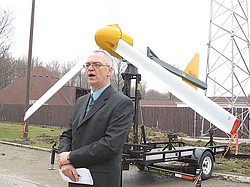Turbine savings in Lordstown? Answer is blowing in the wind
Lordstown Mayor Michael Chaffee stands in front of one of the village’s previously installed wind turbines. Through more than three months of operation, there are questions as to exactly how much money the turbines have saved the village.
By Karl Henkel
LORDSTOWN
Since their installation in mid-March, two wind turbines near the Lordstown Administration Building have shaved costs from the village’s electrical payments.
How much have they saved?
That’s the $131,700 question.
Strictly by the meter, the two 100-foot, 10-kilowatt-hour turbines, which cost $131,700 (of which Lordstown paid $13,170) have trimmed $117.41 from electrical bills from March 22, when they were installed, through June 30.
But officials, including Mayor Michael Chaffee, said the city has saved much more.
“Our bills are significantly lower,” Chaffee told The Vindicator. “If I had to guess, the turbines are producing more than we thought they have.”
Chaffee pointed to electrical bills that spanned mid-April through early June in both 2010 and 2011, and said the village’s payments dropped from $1,935 to $1,483.
The turbines could be the reason for the entire $452 savings, a 23 percent decrease, but Dale Grimm, parks and grounds superintendent for Lordstown who monitors the turbine meter, is frustrated because the readings indicate the $117.41 savings, a 6 percent decrease.
He said the two turbines combined have produced 1,186-kilowatt hours in their first three-plus months.
“I don’t think it’s anywhere near what was projected,” Grimm said. “It’s pretty safe to say I’m disappointed.”
The turbines, on average, are expected to save the village department 30 to 50 percent on its electricity payments, or $300 to $500 a month.
Chaffee and Greg Courtney of Alliance-based Wind Turbines of Ohio LLC , the turbine dealer, said the community should reserve judgment on the success or failure of the turbines until a later date.
“We need to have them up for a year and measure what we saved,” Chaffee said. “I think we have jumped to a lot of conclusions early in the process.”
Both Chaffee and Courtney said the turbines have operated only during the spring and summer, generally the least windy time of the year.
“Ninety percent of the electric made by any turbine in Ohio will be done in September through May,” Courtney said. “January and December could completely offset what was done these last few months and most likely will.
“To make a determination now ... is utterly stupid.”
The National Weather Service in Cleveland backed up Courtney’s claims and said the most windy months in the Youngstown area are December through March.
Aside from a lack of wind, the turbines are less than 4 months old, and they were temporarily shut down for 10 to 12 days when village Councilman Stanley Zoldan, upset that the turbines had not received final electrical inspections before their debut, turned off the power.
All reasons aside, Grimm still questioned the effectiveness of the turbines.
“I don’t see these things doing much better than what they are,” Grimm said. “And we’re pretty much stuck with these wind turbines.”
 43
43

